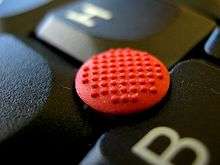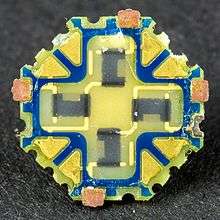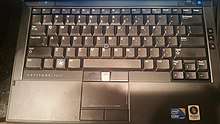Pointing stick
A pointing stick (nub or nipple) is a small joystick used as a pointing device typically mounted centrally in a computer keyboard. Like other pointing devices such as mice, touchpads or trackballs, operating system software translates manipulation of the device into movements of the pointer or cursor on the monitor. Unlike other pointing devices, it reacts to sustained force or strain rather than to gross movement, so it is called an "isometric"[1] pointing device. IBM introduced it commercially in 1992 on its laptops under the name "TrackPoint", patented in 1997.[2]


The pointing stick senses applied force by using two pairs of resistive strain gauges. A pointing stick can be used by pushing with the fingers in the general direction the user wants the cursor to move. The velocity of the pointer depends on the applied force so increasing pressure causes faster movement. The relation between pressure and cursor or pointer speed can be adjusted, just as mouse speed is adjusted.
On a QWERTY keyboard, the stick is typically embedded between the G, H and B keys, and the mouse buttons are placed just below the space bar. The mouse buttons can be operated right-handed or left-handed due to their placement below the keyboard along the centerline. This pointing device has also appeared next to screens on compact-sized laptops such as the Toshiba Libretto and Sony VAIO UX.
Variants
Pointing sticks typically have a replaceable rubber cap, called a nub, which can be a slightly rough "eraser head" material or another shape. [3]
The cap is red on ThinkPads, but is also found in other colours on other machines. For example, it may be grey, black or blue on some Dell models, blue on some HP/Compaq laptops, and green or gray on most Toshiba laptops produced before the 2000s.
Button configurations vary depending on vendor and laptop model. ThinkPads have a prominent middle mouse button, but some models have no physical buttons. Toshiba employs concentric arcs.
In the early 1990s, Zenith Data Systems shipped a number of laptop computers equipped with a device called "J-Mouse", which essentially used a special keyswitch under the J key to allow the J keycap to be used as a pointing stick.
In addition to appearing between the G, H and B keys on a QWERTY keyboard, these devices or similar can also appear on gaming devices as an alternative to a D-pad or analog stick. On certain Toshiba Libretto mini laptops, the pointing stick was located next to the display. IBM sold a mouse with a pointing stick in the location where a scroll wheel is common now.

Optical pointing sticks are also used on some ultrabook tablet hybrids, such as the Sony Duo 11, ThinkPad Tablet and Samsung Ativ Q.
On the Gateway 2000 Liberty laptop the pointing stick is above the enter key on the right side of the keyboard.
A pointing stick was featured in the New Nintendo 3DS as a secondary analog stick, known as the C-Stick.
Design challenges
The IBM TrackPoint III and the TrackPoint IV have a feature called Negative Inertia that causes the pointer's velocity to "overreact" when it is accelerated or decelerated. Negative Inertia is intended to avoid feeling of inertia or sluggishness when starting or stopping movement.[4] Usability tests at IBM have shown that it is easier for users to position the pointer with Negative Inertia, and performance is 7.8% better.[5]
Another challenge with pointing stick design is identification of the zero position (the position where no motion is desired). Because the amount of motion is small, the sensitivity of the sensors must be high, and they are subject to noise interference.
A typical solution, which assumes that pointing sticks frequently go out of calibration, is to interpret a variation below a certain threshold (over a given interval, perhaps one or several seconds) as being a neutral stick. However the recalibration can also allow brief periods of 'drifting' (movement of the cursor while the user is not moving the pointing stick).[6]
In practice, if the re-calibration interval is set too short and if the user applies moderately consistent pressure to the stick for such an interval, this method results in an incorrect zero point. Additional pressure again moves the cursor, but the calibration may occur again, requiring even more force. If the user releases pressure at this point, the change will be interpreted as an instruction to move the opposite direction. In time, the software will re-calibrate and stop the motion.
Additionally, if "press-to-select" is enabled, the software may generate unexpected click events by touching the pointing stick during typing.
Since ThinkPad computers have a nub that is responsive to pressure in a direction, and there is a patent for this, other companies have made it so a person has to move the finger a large distance to cause the nub to rock from side to side in a much less efficient way.
History
In 1984, Ted Selker, a researcher at PARC, worked on a pointing stick based on a study showing that it takes a typist 0.75 seconds to shift from the keyboard to the mouse, and comparable time to shift back. Selker built a model of a device that would minimize this time. It was only three years later, working at IBM, that Selker refined his design, resulting in the TrackPoint product[7] for which IBM received US patents in 1996[8][9] and 2000.[10]
Pointing sticks were the dominant pointing device for laptops before the advent of the touchpad. During later years, they faced a decline in popularity as most laptop-producing brands switched to touchpads, although as of 2017, some manufacturers like Lenovo still produce laptops with pointing sticks.[11]
Problem scope
Space constraints

The pointing stick can be used in ultra-compact netbooks[12] where there would be no place for a touchpad.
Finger motion reduction
The pointing stick is positioned such that the hands do not need to be removed from the home row to manipulate the mouse pointer.[13]
Continuous motion
Some people find them more appealing for mobile gaming than a touchpad, because the track-point allows infinite movement without repositioning.[13] This is because a user's finger may run off the edge of a touchpad while positioning the pointer, requiring them to reposition their finger in order to continue.[14]
Fine positioning
Some users claim it is easier to finely position the pointer than when using a touchpad because there is virtually no "dead zone".
Ergonomics
Some users feel that pointing sticks cause less wrist strain because a user does not need to avoid resting wrists on a touchpad, usually located just below the keyboard. One criticism is that because the pointing stick depends on the user's applying pressure, it can cause hand cramps (although this can be partly solved by setting the sensitivity higher and lifting the finger when the pointer is not being moved). Another criticism is that it stresses the index finger and may lead to repetitive strain injury.
A number of ergonomic studies to compare trackpoint and touchpad performance have been performed.[15][16] Most studies find that touchpad is slightly faster; one study found that "the touchpad was operated 15% faster than the trackpoint".[17] Another study found that average object selection time was faster with a touchpad, 1.7 seconds compared to 2.2 seconds with a trackpoint, and object manipulation took 6.2 seconds with a touchpad, on average, against 8.1 seconds with trackpoint.[18]
Naming and brands
| Name | Brand | Current Models | Past Models | Color |
|---|---|---|---|---|
| Acer | FineTrack | None | TravelMate 6410, 6460, 6492, 6492G, 6592, 6592G, 6593 | Green |
| Asus | SensePoint | ASUS pro B8230UA | S200, S200N, S300N | ? |
| Casio | ? | Cassiopeia Fiva MPC series | ||
| Dell | TrackStick, Dual Point | Latitude: 5490/5495, 5590, 7490 Precision: 3530, 5530, 7530, 7730 | Latitude: 13": E4300, E4310, E6320, E6330; 14": E5400, E5410, E5420, E5430, E5440, E5450, E5470, 5480, E6420, E6430, 6430u, E7440, E7450, E7470, 7480; 15": E5530, E5540, E5550, E5570, 5580, E6500, E6510, E6520, E6540, Retro Latitude: D400, D410, D420, D430, D600, D610, D620, D630, D800, D810, D820, D830, XT; Precision: M2300, M2400, M4300, M4400, M4500, M4600, M4700, M4800, M6700, M6800, M6400, M6500, 3510, 3520, 5510, 5520, 7510, 7520, 7710, 7720; Inspiron: 4000, 8100, 8200, 8600, 9100; L | Blue, black or gray |
| Elonex | Mouse emulator | Elonex ONE | None | None |
| Fujitsu | StickPoint, QuickPoint, Quick Touch[19] | None | Lifebook T2010, T2020, S7110, S7210, S7220, B2400/2500/2600 series, E8310 (optional), E8410 (optional), E8420 (optional), U1010/U810/U50, U820/U2010, P1100/1500/1600 series, P1620, P1610, P1630, P2120, | Black or blue |
| GPD | ? | None | Pocket 1 | ? |
| HP | PointStick | All EliteBooks excluding 1000 series and Folio; Some ZBooks excluding Studio series; ProBook 6450b, 6455b & 6550b | All EliteBooks excluding 1000 series; all models ending with p or w; all models starting with nc, nw or c; 6445b (optional), 6545b (optional), tc4200, tc4400; Presario models starting with v, 8500 | Black, orange or blue (older models) |
| Lenovo (formerly IBM) | TrackPoint | All ThinkPads, excluding chromebooks; Travel Keyboard with Ultranav | Most ThinkPads, Space Saver II, Model M13, Model M4-1, Trackpoint IV, Trackpoint USB Keyboard, TransNote, Trackpoint Mouse | Red |
| NEC | NX Point | None | EasyNote MX45, MX65, S5 | None |
| Nintendo | C-Stick | New Nintendo 3DS, New Nintendo 3DS XL and New Nintendo 2DS XL[20][21] | None | Gray |
| Samsung | Pointing stick | Series 6, Ativ Q | Series 4 | All colors |
| Sony | Pointing stick | Sony PS3 Wireless Keyboard[22] | Sony Vaio Duo 11, Sony VAIO P series, BX series, C1 series, U8 series, UX series, X505 | None |
| Sprintek | FlexPoint | SK8702/SK8703 for Laptop/Tablet PC/Netbook/Industrial Keyboard | None | None |
| Toshiba | AccuPoint | Tecra R Series, Z Series and W Series, Portege Z Series and R Series | Portégé (not current models 06/2007), 300-7000 series, T3000 series; Tecra series 500-9000, A7, A8, A9, A10, A11, M2, M5, M9, M10, M11, S Series; Satellite Pro series 400-4000, T2000; Satellite 100-4000 series, Libretto 50CT, 70CT, 100CT | Green, blue |
| Unicomp | Pointing stick | EnduraPro (for desktop) | On-The-Stick, Mighty Mouse | Red |
Other uses
While typically employed on a computer keyboard, IBM included one on its Trackpoint Mouse product; suggested uses included scrolling (as with a scroll wheel) or a dual-cursor system.[25]
References
- "WO2001014957A1 - Control stick for a finger pointing device - Google Patents". Google. 2001-03-01. Retrieved 2020-08-17.
- "US6115030A - Trackpoint device - Google Patents". Google. 1997-12-18. Retrieved 2020-08-17.
- "Lenovo Support and Downloads: TrackPoint Caps and how to order for ThinkPad systems and TrackPoint Keyboards". IBM.com. 2007-07-17. Retrieved 2009-04-06.
- US 5570111, Robert C. Barrett; Robert S. Olyha, Jr. & Joseph D. Rutledge, "Graphical user interface cursor positioning device having a negative inertia ...", issued 1996-10-29
- R. C. Barrett; E. J. Selker; J. D. Rutledge*; R. S. Olyha* (1995). "Negative Inertia: A Dynamic Pointing Function". SIGCHI. Retrieved 2012-12-03. Cite journal requires
|journal=(help) - "R/Thinkpad - Track point drift".
- Golden, Peter. "The development of the IBM ThinkPad, Part I: big BLUE'S big ADVENTURE". Retrieved 2012-12-03.
- US 5521596, Edwin J. Selker & Joseph D. Rutledge, "Analog input device located in the primary typing area of a keyboard", issued 1996-05-28
- US 5489900, Matthew F. Cali; Jerome J. Cuomo & Donald J. Mikalsen et al., "Force sensitive transducer for use in a computer keyboard", issued 1996-02-06
- US US6115030, Viktors Berstis & Thomas Guthrie Zimmerman, "Trackpoint device", issued 2000-09-05
- Osborne, Joe (2017-06-21). "Why the ThinkPad TrackPoint is still a thing, according to Lenovo's chief designer". TechRader. Future Publishing. Retrieved 2018-08-13.
- Miller, Paul (2009-01-07). "Sony VAIO P hands-on". Engadget. Retrieved 2012-12-03.
- Lee, Jon (2007-04-25). "Trackpoint vs Touchpad". jonlee.ca. Archived from the original on 2007-04-29.
- "Looking for Nub: Best and Worst Notebook Pointing Sticks". www.laptopmag.com. Retrieved 2016-04-25.
- Batra, S.; Dykstra, D.; Hsu, P.; Radle, K.; Wiedenbeck, S. (1998). "Pointing device performance for laptop computers". Proceedings of the Human Factors and Ergonomics Society 42nd Annual Meeting. Human Factors Society: 535–540.
- Sutter, C.; Ziefle, M (2005). "Interacting with notebook input devices: An analysis of motor performance and users' expertise". Human Factors. Human Factors Society. 47 (1): 169–187. doi:10.1518/0018720053653893. PMID 15960095.
- Sutter, Christine; Armbrüster, Claudia; Oehl, Michael; Müsseler, Jochen (2008). "Office work places with laptop computers: User specific requirements for input devices and software design" (PDF). USA Publishing. Cite journal requires
|journal=(help) - Sutter, C.; Ziefle, M. (2003). How to handle notebook input devices: an insight in button use strategy. Contemporary Ergonomics 2003. Taylor & Francis Group. pp. 241–251. ISBN 9780415309943.
- "Support & Downloads". Fujitsu. 2002-12-01. Retrieved 2020-08-17.
- "Controller".
- "New Nintendo 3DS XL Review". PC Magazine. 2015-02-04. Retrieved 2018-06-19.
- "Japan scores official Bluetooth PS3 keyboard for ¥5,000". Retrieved 2013-05-25.
- Munroe, Randall (2007-04-02). "Appropriate Term". xkcd. Retrieved 2014-01-26.
- Eric S. Raymond, Guy L. Steele Jr.; et al. "nipple mouse". Jargon File. Retrieved 2011-07-08. Based on The New Hacker's Dictionary. MIT Press. 1996. ISBN 9780262680929.
- "TrackPoint Mouse". IBM. Retrieved 2012-12-03.
External links
- Pointing stick USB Keyboard Comparison
- How to configure the TrackPoint under Linux
- Notebook input devices put to the age test : the usability of trackpoint and touchpad for middle-aged adults Ergonomics, 2007, vol. 50, no3, pp. 426–445
- an OEM supplier for nubs: http://sofpoint.com/
- ALPS (manufacturer)
- Synaptics (manufacturer)